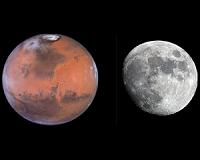 |
Washington DC (SPX) Jan 29, 2010 A discovery by two amateur astronomers in central Florida helped to set in motion a global network of ground- and space-based telescopes today, observing a violent explosion of a distant star in our Galaxy. The two astronomers, Dr. Barbara Harris of New Smyrna Beach and Shawn Dvorak of Clermont, were active participants in a global research campaign to monitor activity of the star U Scorpii. Their detection of this explosion in the early morning hours of January 28 served as the trigger for a number of satellites and ground-based telescopes waiting on this important event. U Sco, an object known as a recurrent nova, had been predicted to outburst during a two-year window beginning in the spring of 2008. Both Harris and Dvorak had been conducting long-term monitoring as part of a campaign run by the American Association of Variable Star Observers (AAVSO). This campaign, organized by Dr. Bradley Schaefer (Louisiana State University), involved professional and amateur observers from around the world monitoring this star every night throughout that two-year window. Their persistence paid off early in the morning of January 28. Harris was first to detect the outburst shortly before 6 a.m. local time, with Dvorak's independent detection arriving shortly afterward. The two near-simultaneous observations provided all the proof required to alert observers and observatories around the world and in space that U Sco's outburst had finally occurred. Within an hour, Schaefer set in motion the global network of observatories, and by the end of the morning, two X-ray satellites (the Rossi X-Ray Timing Observatory and the INTEGRAL satellite) had already made observations. Over the next several months, astronomers will be monitoring the progress of this outburst at nearly all wavelengths of light from radio waves to X-rays using a number of ground-based telescopes and spaceborne observatories. Dr. Arne Henden, Director of the AAVSO, commented that "this again shows the real advantage of the worldwide distribution of amateur astronomers for detecting transient events like this. Harris and Dvorak could watch U Sco rise over the Atlantic, hours before professional astronomers in the Western U.S. would have a chance. Then, because of the winter weather for most U.S. professional observatories, amateurs continued monitoring U Sco from New Zealand and Australia, catching the important first hours of the outburst." The AAVSO's Observing Campaign coordinator, Dr. Matthew Templeton, notes that amateur astronomers play an important role in time-critical projects such as this. "Amateurs have the option of observing what they want, when they want. Sometimes, the only source of observational data for projects such as this is the amateur community. The observers of the AAVSO have been working with the professional community for decades to provide this kind of help. It's a key part of the process of doing scientific research, and the work of the amateur community makes it possible." Amateur astronomers around the world will continue to participate in the observing campaign, providing data to complement the observations made by larger ground- and space-based telescopes. The progress of the U Scorpii outburst can be followed via the internet; the AAVSO is maintaining a web page devoted to the event, and anyone can view observational data as they are submitted in real time through the AAVSO website.
Share This Article With Planet Earth
Related Links U Scorpii and the AAVSO campaign Astronomy News from Skynightly.com
 Mars Pairs Up With Full Moon
Mars Pairs Up With Full MoonWashington DC (SPX) Jan 28, 2010 One of the skywatching highlights of the year takes place on the night of January 29, as the full Moon and the planet Mars march high across the sky, according to the editors of StarDate magazine. Mars and the Moon are low in the east-northeast at nightfall, with the Red Planet to the left of the Moon. Mars looks like a brilliant orange star. One reason this is such a grand spectacle is th ... read more |
|
| The content herein, unless otherwise known to be public domain, are Copyright 1995-2009 - SpaceDaily. AFP and UPI Wire Stories are copyright Agence France-Presse and United Press International. ESA Portal Reports are copyright European Space Agency. All NASA sourced material is public domain. Additional copyrights may apply in whole or part to other bona fide parties. Advertising does not imply endorsement,agreement or approval of any opinions, statements or information provided by SpaceDaily on any Web page published or hosted by SpaceDaily. Privacy Statement |